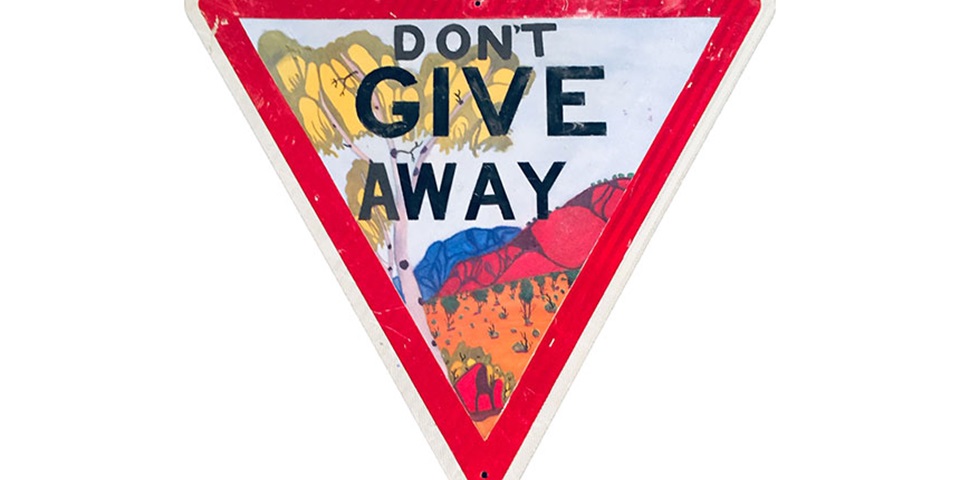Blog
Flipping the narrative

Murdoch University Art Collection Assistant Curator, Dr Baige Zylstra, took some time out from managing the collection to highlight some of her favourite work.
It was tough to choose, but ultimately, her selections were driven by a belief that some of the most powerful artworks in the collection right now are works by contemporary Indigenous artists.
“Over the last decade or so, I think contemporary Indigenous artists have been producing some of the most exciting visual art which challenges traditional Western ideas and histories of art, and cleverly flips the narrative. This is a strong feature of the Murdoch University Art Collection and is important in the wider University context too," said Baige.
Here are the works Baige has selected from the collection that she feels illustrate this perfectly.
The first selection is a 2009 work by Danie Mellor, titled An Encounter with the Establishment. Mellor, who is of mixed Indigenous and Anglo-Australian heritage, creates prints, drawings and installations which consider Australia’s colonial past and its legacies today. His works explore themes that are critically linked to cultural histories and concepts of the landscape. Delving into the tensions of his own ancestry, Mellor articulates a post-colonial history of Australia with a similar mixed European and Aboriginal heritage.

Danie MELLOR
An Encounter with the Establishment 2009
Wax pastel, wash with oil pigment, watercolour, pencil, glitter, Swarovski crystals on paper
57.5 x 88cm
Purchased 2011
Murdoch University Art Collection
Mellor has represented this hybridity in his work through the motif of Enlightenment-era depictions of non-European cultures, such as the Chinese-inspired willow pattern of late-18th century porcelain. Borrowing the styles of 18th-century prints and engravings to depict Australian animals and Aboriginal people, and framing these works in ornate Baroque-style frames, Mellor mines the tension between the Enlightenment’s call for the universal rights of man and the project of colonisation, both of which occurred simultaneously in Australia.
Baige’s second choice is a work acquired by the Collection a decade ago. Noongar artist Sandra Hill’s Homemaker series reflects on her life experiences and those of her sister, mother, aunty and grandmother, all of whom were Stolen Generation survivors. Each painting in the Homemaker series depicts an Aboriginal woman in a Booka (kangaroo-skin cloak), situated in a brightly coloured domestic setting with white people who are rendered in grey tones.


Sandra HILL
Home-Maker #7 - Cake Making 2012
Oil on canvas
76 x 91cm
Purchased 2012
Murdoch University Art Collection
In Home-Maker #7 - Cake Making, Hill presents an Aboriginal woman in a kitchen setting surrounded by white women who are making a cake. Hill explained that during the 1950s, many Aboriginal families were placed into Government housing where they were trained in the ways of Western life. As part of this ‘re-education’ project, white women were sent into the homes of Aboriginal people to train the women in domestic work.
In this painting, the Aboriginal woman sits passively observing this cake-making ritual, and the white women are oblivious to her sense of exclusion, discomfort and sadness at having to be in this situation. The presence of the Booka, which cloaks and protects the Aboriginal woman, is a powerful symbol of cultural defiance and represents her stance in preserving and maintaining the traditions of her culture.
For her final selection, Baige chose a 2021 work by Mervyn Rubuntja titled Don't Give Away, which is one of a series of paintings on recycled road signs made by artists from the Iltja Ntjarra (Many Hands) Art Centre based in Mparntwe in the Northern Territory. Iltja Ntjarra artists experiment with materials, forms and methods of making to depict the beauty of their Country in the painting style made famous by Albert Namatjira of whom they are direct descendants.


Mervyn RUBUNTJA
Don’t Give Away 2021
Acrylic painting on recycled road sign
96 x 96 x 96cm
Purchased 2022 to commemorate the 50th anniversary of Murdoch University Art Collection
In this series of works, the group repurposed discarded road signs, found everywhere in Mparntwe, as a means of sharing a political message. Whether used to direct traffic, or to communicate specific rules, signs like these are crucial in governing our relationship to the land. Usually these signs are used to direct people’s attention to common conventions around road traffic, private property, and the organisation of space.
In the hands of the Iltja Ntjarra artists, their function is subverted to communicate important information relating to Country, its beauty, cultural practices, and customary lore on traditional lands. Each sign has been painted with images of Country in the Hermannsburg style alongside text which urges us to look after the land, warning that it is not something to be owned or taken advantage of for profit.
“These and other works in the Collection convey really powerful messages, in a way that is engaging, provocative, and encourages greater dialogue and consideration of Indigenous perspectives. I think these kind of works are incredibly important in the wider University context and highlight the cultural and educational value of the collection.”
Blog
Flipping the narrative
Posted on
Thursday 8 December 2022
